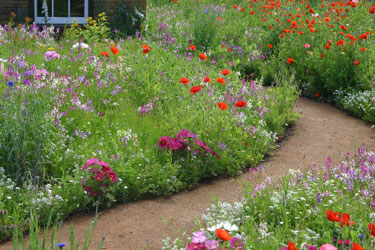Kids Go Gardening - wildflowers
Nature works in so many wonderful ways, but sometimes she needs a helping hand – yours will do!
Wild flowers grow in places like meadows (fields), forests or woodlands, and on riverbanks and mountain slopes . Most wild flowers only grow for one spring and summer season. Their seeds are scattered by the wind or animals. When autumn arrives, the wildflowers stop flowering and the plants die. The seed produced in autumn germinates the following spring to start the growth cycle all over again.
How do I grow wildflowers?
Because wild flowers are wild and not used to being pampered, they’re pretty easy to please. They are best sown in spring or autumn, but not the middle of summer when it’s hot and dry, or the middle of winter when it’s cold and wet. Here’s how…
- Remove the grass and weeds from a patch of garden.
- Rake the soil lightly to about 1cm deep.
- Wait 2–3 weeks for weeds to come up, then clear them away again.
- Scatter wild flower seed evenly over the soil.
- Rake the soil to lightly cover the seeds.
- Wild flowers don’t like rich soil so don’t feed them with fertiliser.
- Water the soil and keep moist for 4 – 6 weeks.
- Flowers should start to appear after about 8 weeks.
Wild flowers to grow from seed
Cosmos, Shirley poppies,
Soldier poppies,
Californian poppies,
Cornflowers,
Calendula, Larkspur,
Linaria,
Nemophila,
Alyssum,
Phacelia.
Make a mix of your favourite flowers or choose a readymade mix like Yates Wildflower World.
Caring for your wild flower patch
- Weed and water through summer.
- Clear away dead plants in autumn.
- Scatter seeds from any flowers you have – these should germinate before winter.
- Sow more wild flower seed in the second spring to build up the wild flower population.
Why are wildflowers important?
Lots of gardens these days don’t have as many nectar-rich flowers, or as many different types of plants, as they did in the olden days. This means less food and less variety of food for insects, which results in far fewer insects in our gardens. Wild flowers produce lots of yummy nectar that helps attract and feed insects like bees.
Why are insects important?
Bees and other pollinating insects are really important because they pollinate our food crops. Without these busy little creatures, our fruit trees and tomato plants wouldn’t produce any fruit – YIKES!! In fact, if we wanted any fruit at all, we would have to go around pollinating the flowers ourselves, by brushing the flowers together. So...pollinating insects not only make food for us, they save us a lot of time too!
Bee friendly!
Honey bees are the unsung heroes of the garden, pollinating our fruit trees, beans and tomatoes. But worryingly, bees are dying out all over the world and no one really knows why. Encourage bees to visit your garden and neighbourhood by :
- Planting plenty of nectar-rich plants (like wildflowers).
- Knowing the difference between bees and wasps – don’t kill bees.
- Placing drinking stations around your garden for foraging bees: fill shallow dishes with water and a few sticks for the bees to land on (so they don’t drown).
- Telling your mum and dad, if they really have to spray the garden, to use ‘bee friendly’ pesticides.
- Taking the time to learn more about these smart little creatures - they are fascinating!
Unable to see red, bees are attracted to white, yellow and blue flowers (including ultra violet, which humans cannot see). They also have an excellent sense of smell and are attracted to flowers that produce ample pollen and nectar. Simple old-fashioned ‘single’ flowers are best.
Bee favourites include; alyssum, salvia (sage), lavender, rosemary, catmint, cosmos, aster, borage, thyme, monarda (bee balm), and fruit trees.

5-Jan-2023

A wildflower garden

